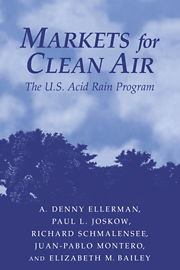Book contents
- Frontmatter
- Contents
- List of Illustrations
- List of Tables
- Preface
- Acknowledgments
- Part I Background
- 1 A Market-Based Experiment
- 2 A Political History of Federal Acid Rain Legislation
- 3 The Political Economy of Allowance Allocations
- 4 The Pre-1995 Trend in SO2 Emissions
- Part II Compliance and Trading
- Part III Questions and Implications
- Appendix: Effect of Title IV on SO2 Emissions and Heat Input by Susanne M. Schennach
- Bibliography
- Index
1 - A Market-Based Experiment
Published online by Cambridge University Press: 10 December 2009
- Frontmatter
- Contents
- List of Illustrations
- List of Tables
- Preface
- Acknowledgments
- Part I Background
- 1 A Market-Based Experiment
- 2 A Political History of Federal Acid Rain Legislation
- 3 The Political Economy of Allowance Allocations
- 4 The Pre-1995 Trend in SO2 Emissions
- Part II Compliance and Trading
- Part III Questions and Implications
- Appendix: Effect of Title IV on SO2 Emissions and Heat Input by Susanne M. Schennach
- Bibliography
- Index
Summary
A STAR IS BORN (?)
More than thirty years ago, Dales (1968) demonstrated that, in theory, an emissions-trading system, in which rights to emit pollution are available in fixed and limited aggregate amount and are freely tradable, would induce rational firms to reduce pollution at the least possible cost. This basic theoretical argument has been refined and elaborated many times since. Over this same period, the alternative command-and-control approach to environmental policy, in which the design or performance of individual pollution sources is specified, has been applied to a wide variety of problems and has generally performed poorly, with excessive costs and, often, failure to achieve environmental objectives. Nonetheless, until quite recently, emissions trading and related approaches (such as emission taxes) attracted little but hostility from noneconomists and were rarely employed in practice.
Then, with relatively little fanfare, Title IV of the 1990 Clean Air Act Amendments (1990 CAAA, Public Law 101–549), the U.S. Acid Rain Program, passed by the U.S. Congress and signed by President George Bush in 1990, established the first large-scale, long-term U.S. environmental program to rely on tradable emission permits (called “allowances” in the legislation) to control emissions. Its target was electric utility emissions of sulfur dioxide (SO2), the major precursor of acid rain.
Since 1990, policymakers' interest in emissions trading has grown rapidly. This growth accelerated in 1995, when Title IV came into effect. Most observers quickly judged the program to be a great success, largely because the price of emission rights (allowances) was well below expectations.
- Type
- Chapter
- Information
- Markets for Clean AirThe U.S. Acid Rain Program, pp. 3 - 12Publisher: Cambridge University PressPrint publication year: 2000



